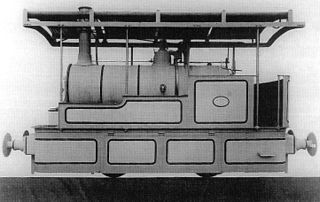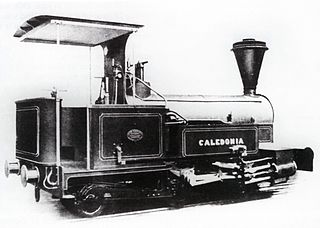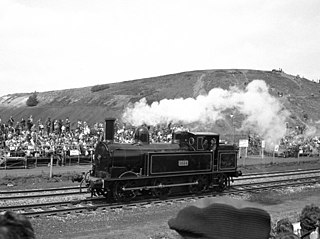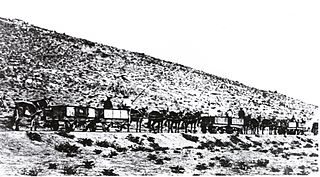
The Namaqualand Railway was a 2 ft 6 in (762 mm) narrow gauge railway operating between Port Nolloth and O'okiep in the Namaqualand region of the former Cape Colony in South Africa. It was originally a mule-drawn railway built to provide an outlet for the copper mines of the region. Constructed between 1869 and 1876, the railway was 93 1⁄2 miles (150 kilometres) long, with an additional 8 miles purely associated with the copper mine workings. Although owned by the Cape Copper Company, the railway always operated as a public railway. [1] [2]

2 ft 6 in gauge railways are narrow gauge railways with track gauge of 2 ft 6 in. This type of rail was promoted especially in the colonies of the British Empire during the second half of the nineteenth century by Thomas Hall and Everard Calthrop.

Port Nolloth is a town and small domestic seaport in the Namaqualand region on the northwestern coast of South Africa, 144 kilometres (89 mi) northwest of Springbok. It is the seat of the Richtersveld Local Municipality.

Namaqualand is an arid region of Namibia and South Africa, extending along the west coast over 1,000 kilometres (600 mi) and covering a total area of 440,000 square kilometres (170,000 sq mi). It is divided by the lower course of the Orange River into two portions – Little Namaqualand to the south and Great Namaqualand to the north.
The railway pre-dated the construction of 3 ft 6 in (1,067 mm) railways in South Africa. Because of the success of the Namaqualand line, 2 ft 6 in (762 mm) gauge was strongly promoted by civil engineer R. Thomas Hall, Superintendent of the narrow gauge Redruth and Chacewater Railway in Cornwall who was involved in the construction of the Namaqualand Railway, as the primary gauge for railway construction in South Africa. The final decision was a compromise between the two recommended gauges and the 3 ft 6 in (1,067 mm) came into existence in Africa. [1] [3]
Richard Thomas Hall, born 31 May 1823, was a British railway engineer. Died 1889.
The Redruth and Chasewater Railway,, was an early mineral railway line in Cornwall, England, UK. It opened in 1825 and was built to convey the output from copper mines in the Gwennap area to wharves on Restronguet Creek around Devoran, and to bring in coal to fuel mine engines; later it carried timber for pit props and also house coal.
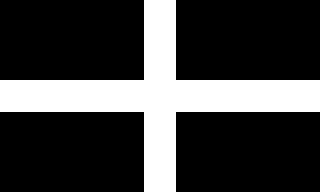
Cornwall is a county in South West England in the United Kingdom. The county is bordered to the north and west by the Celtic Sea, to the south by the English Channel, and to the east by the county of Devon, over the River Tamar which forms most of the border between them. Cornwall forms the westernmost part of the South West Peninsula of the island of Great Britain. The furthest southwestern point of Great Britain is Land's End; the southernmost point is Lizard Point. Cornwall has a population of 563,600 and covers an area of 3,563 km2 (1,376 sq mi). The county has been administered since 2009 by the unitary authority, Cornwall Council. The ceremonial county of Cornwall also includes the Isles of Scilly, which are administered separately. The administrative centre of Cornwall, and its only city, is Truro.
After copper mining ceased in 1928 the railway was temporarily closed until 1937 when mining activities resumed. [4]
The Namaqualand Railway finally closed in 1944. [2]
